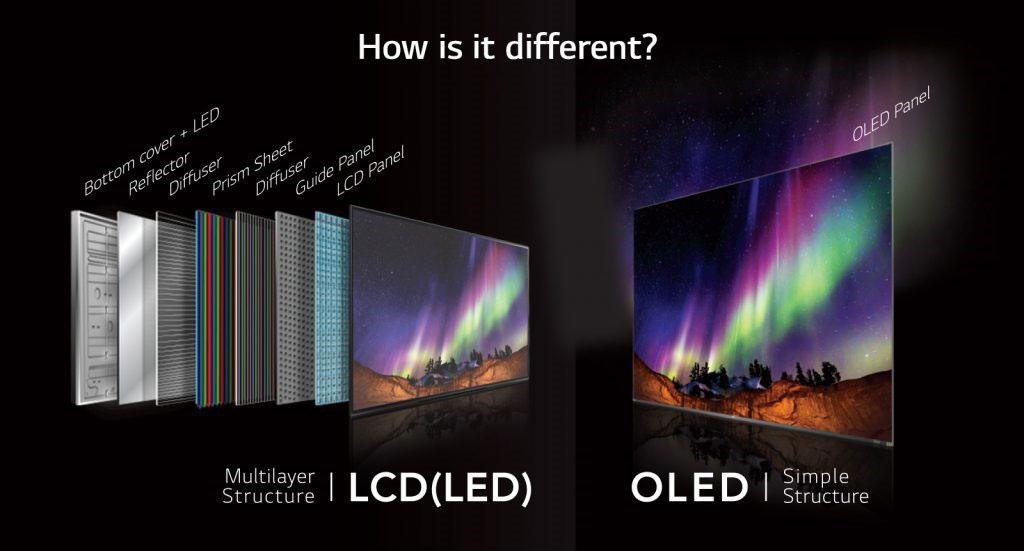The term OLED, which stands for Organic Light Emitting Diode, is widely recognized as a contemporary type of display. Despite the fact that many companies still utilize LCDs, the surging demand for OLEDs is surpassing the market for LCDs.
Conventional LCDs rely on a backlight source such as CCFL or cold-cathode fluorescent lamps. On the other hand, OLEDs use organic substances to generate light in various colour combinations without the requirement of any backlight. In LCDs, the LED backlight’s light passes through a layer of crystal material.
In this blog article, we will evaluate OLEDs and LCDs based on various criteria.
Comparison Between OLED and LCD
Brightness: LCDs have an advantage over OLEDs in terms of full-screen brightness with their LED backlights. However, in modern displays, brightness is not as critical for image clarity and light output.
Contrast Ratio: The standard contrast ratio of computer LCDs is typically around 1000:1, while LCD TVs may have a contrast ratio of around 4000:1. In contrast, OLED displays can achieve a contrast ratio of up to 1,000,000:1. A higher contrast ratio means better picture quality. Since OLEDs have true black and can turn off pixels to display black colour, unlike LCDs, they are a better option for contrast and picture quality.
Refresh Rates: The refresh rate is the number of times a display presents a new image per second. OLEDs switch images faster than LCDs, with today’s OLED displays having a 120Hz refresh rate compared to the traditional 60Hz refresh rate of LCDs. However, OLEDs still exhibit motion blur, which is a challenge for aspiring electronic equipment manufacturers.
Power Consumption: LCDs always need a backlight to illuminate their pixels, while OLEDs use organic materials to emit light and create an image. True black is another reason why OLEDs consume less power than LCDs. The brightness of the displayed image affects the power consumption of both display types. LCDs can be made more energy-efficient than OLEDs by reducing the LED backlight’s brightness.
Viewing Angle: OLEDs have an advantage over LCDs in terms of viewing angle. When viewing an LCD display from an off-axis position, the image may not appear as it should since the visuals fade away. However, this is not the case with OLED displays.
Key Benefits and Advantages of Using OLED and LCD Display Modules
High-Quality Picture and Efficient Lighting: Both OLED and LCD screens offer a high-quality display of vibrant colours. LCD screens produce brilliant colours through a backlight that shines colours through the crystals on the surface, while OLED screens produce their own light. OLED screens have the added advantage of producing rich blacks and great depth of colour due to the ability to turn off individual pixels, creating great contrast. LCD screens also deliver high contrast ratios by adjusting their crystals to match darker colours. Both OLED and LCD screens are thin and lightweight, making them easy to mount. OLED screens come in curved designs and large displays, making them ideal for home entertainment. LCD screens also offer a wide range of uses with their large displays.
Cost-Effective and Convenient: Both OLED and LCD screens come in energy-saving options, with LCD screens typically designed to conserve energy and OLED screen manufacturers developing new energy-saving technology. Investing in a reliable OLED or LCD screen from trusted suppliers like Royal Display can result in significant savings over time since newer models are built to increase performance while using less electricity and do not drain power when not in use. Therefore, OLED and LCD screens are cost-effective over the long term.
Durability and Lifespan: Both OLED and LCD screens are known for their durability, with the ability to withstand a fair amount of wear and tear. OLED screens have an advantage in this area, as they do not have a backlight that can burn out or suffer from other technical issues. This means that OLED screens can have a longer lifespan than LCD screens, which may need repairs or replacements due to backlight issues.
Compatibility and Availability: Both OLED and LCD screens are widely available and compatible with a range of devices. Whether you are looking to install a screen in a car, a smartphone, or a TV, you can find both OLED and LCD options. Additionally, both screen types are compatible with various operating systems and can be easily integrated into different devices.
Viewing Angles and Flexibility: OLED screens have an advantage in terms of viewing angles, as they offer better visibility from various angles compared to LCD screens. Additionally, OLED screens can be made flexible and bendable, which makes them suitable for curved displays and other applications where flexibility is desired. While LCD screens can also be made flexible, they are typically less flexible than OLED screens due to the limitations of the backlight technology.
Conclusion
Royal Display stands out as a leading manufacturer and supplier of high-quality LED and OLED display modules. With a focus on innovation, efficiency, and customer satisfaction, Royal Display has consistently delivered cutting-edge technology and exceptional products to clients in various industries. From small-scale applications like smartwatches to large-scale applications like TV displays, Royal Display’s range of products with the latest capabilities of OLED displays ensures that clients can find the perfect fit for their needs. As a reliable and trusted partner in the display module industry, Royal Display continues to push the boundaries of what is possible and deliver exceptional products to clients around the world.






